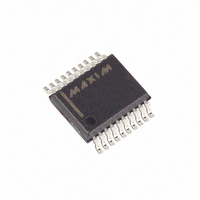MAX4507EAP+ Maxim Integrated Products, MAX4507EAP+ Datasheet - Page 10

MAX4507EAP+
Manufacturer Part Number
MAX4507EAP+
Description
IC SIGNAL LINE PROTECTOR 20-SSOP
Manufacturer
Maxim Integrated Products
Type
Overvoltage protectionr
Datasheet
1.MAX4507CWN.pdf
(12 pages)
Specifications of MAX4507EAP+
Applications
Control systems
Mounting Type
Surface Mount
Package / Case
20-SSOP
Lead Free Status / RoHS Status
Lead free / RoHS Compliant
As seen in Figure 7, the signal input can now be put
into pin 1 of the MAX4506 (new common output for sys-
tem), and outputs can be taken at MAX4508 pins 4 to
7, and 9 to 12. This is the classic demultiplexer opera-
tion. This system now has full protection on both of the
multiplexers’ inputs and outputs.
Measuring path resistance requires special techniques,
since path resistance varies dramatically with the IN
and OUT voltages relative to the supply voltages.
Conventional ohmmeters should not be used for the fol-
lowing two reasons: 1) the applied voltage and currents
are usually not predictable, and 2) the true resistance is
a function of the applied voltage, which is dramatically
altered by the ohmmeter itself. Autoranging ohmmeters
are particularly unreliable.
Figure 8 shows a circuit that can give reliable results.
This circuit uses a 100mV voltage source, a low-volt-
age-drop ammeter as the measuring circuit, and an
adjustable supply to sweep the analog voltage across
its entire range. The ammeter must have a voltage drop
of less than one millivolt (up to the maximum test cur-
rent) for accurate results. A Keithley model 617 elec-
trometer has a suitable ammeter circuit, appropriate
ranges, and a built-in voltage source designed for this
type of measurement. Find the path resistance by set-
ting the analog voltage, measuring the current, and cal-
culating the path resistance. Repeat the procedure at
each analog and supply voltage.
Fault-Protected, High-Voltage
Signal-Line Protectors
Figure 8. Path-Resistance Measuring Circuit
10
ADJUSTABLE
______________________________________________________________________________________
VOLTAGE
ANALOG
100mV
V
IN
4
PATH RESISTANCE = 100mv/A
Measuring Path Resistance
IN1
V-
MAX4506
OUT1
V+
V
8
OUT
A
V+
Note: It is important to use a voltage source of 100mV
or less. As shown in Figure 8, this voltage and the V
voltage form the V
could cause OUT to go into a fault condition prematurely.
These devices are not high-voltage arresters, nor are
they substitutes for surge suppressors. However, the
MAX4506/MAX4507 can fill a vital gap in systems that
use these forms of protection (Figure 9). Although surge
suppressors are extremely fast shunt elements, they
have very soft current knees. Their clamp voltage must
be chosen well above the normal signal levels, because
they have excessive leakage currents as the analog
signal approaches the knee. This leakage current can
interfere with normal operation when signal levels are
low or impedance is high. If the clamp voltage is too
high, the input can be damaged.
Connecting a MAX4506/MAX4507 after a surge sup-
pressor allows the surge-suppressor voltage to be set
above the supply voltage (but within the overvoltage
limits), dramatically reducing leakage effects (Figure 9).
During a surge, the surge suppressor clamps the input
voltage roughly to the ±10V supplies.
Figure 9. Surge-Suppression Circuit
SURGE SUPPRESSORS
-15V
High-Voltage Surge Suppression
OUT
1
2
3
4
IN1
IN2
IN3
V-
voltage. Using higher voltages
MAX4506
OUT1
OUT2
OUT3
V+
8
7
6
5
OP AMP
+10V
-10V
IN











